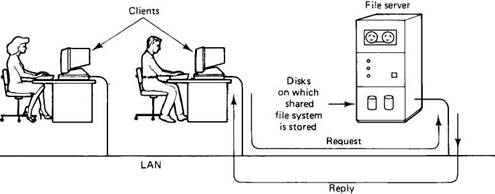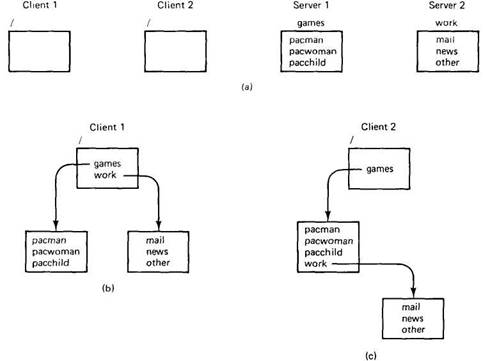Книга: Distributed operating systems
1.4.1. Network Operating Systems
1.4.1. Network Operating Systems
Let us start with loosely-coupled software on loosely-coupled hardware, since this is probably the most common combination at many organizations. A typical example is a network of workstations connected by a LAN. In this model, each user has a workstation for his exclusive use. It may or may not have a hard disk. It definitely has its own operating system. All commands are normally run locally, right on the workstation.
However, it is sometimes possible for a user to log into another workstation remotely by using a command such as
rlogin machine
The effect of this command is to turn the user's own workstation into a remote terminal logged into the remote machine. Commands typed on the keyboard are sent to the remote machine, and output from the remote machine is displayed on the screen. To switch to a different remote machine, it is necessary first to log out, then to use the rlogin command to connect to another machine. At any instant, only one machine can be used, and the selection of the machine is entirely manual.
Networks of workstations often also have a remote copy command to copy files from one machine to another. For example, a command like
rcp machine1:file1 machine2:file2
might copy the file file1 from machine1 to machine2 and give it the name file2 there. Again here, the movement of files is explicit and requires the user to be completely aware of where all files are located and where all commands are being executed.
While better than nothing, this form of communication is extremely primitive and has led system designers to search for more convenient forms of communication and information sharing. One approach is to provide a shared, global file system accessible from all the workstations. The file system is supported by one or more machines called file servers. The file servers accept requests from user programs running on the other (nonserver) machines, called clients, to read and write files. Each incoming request is examined and executed, and the reply is sent back, as illustrated in Fig. 1-9.

Fig. 1-9. Two clients and a server in a network operating system.
File servers generally maintain hierarchical file systems, each with a root directory containing subdirectories and files. Workstations can import or mount these file systems, augmenting their local file systems with those located on the servers. For example, in Fig. 1-10, two file servers are shown. One has a directory called games, while the other has a directory called work. These directories each contain several files. Both of the clients shown have mounted both of the servers, but they have mounted them in different places in their respective file systems. Client 1 has mounted them in its root directory, and can access them as /games and /work, respectively. Client 2, like client 1, has mounted games in its root directory, but regarding the reading of mail and news as a kind of game, has created a directory /games/work and mounted work there. Consequently, it can access news using the path /games/work/news rather than /work/news.
While it does not matter where a client mounts a server in its directory hierarchy, it is important to notice that different clients can have a different view of the file system. The name of a file depends on where it is being accessed from, and how that machine has set up its file system. Because each workstation operates relatively independently of the others, there is no guarantee that they all present the same directory hierarchy to their programs.

Fig. 1-10. Different clients may mount the servers in different places.
The operating system that is used in this kind of environment must manage the individual workstations and file servers and take care of the communication between them. It is possible that the machines all run the same operating system, but this is not required. If the clients and servers run on different systems, as a bare minimum they must agree on the format and meaning of all the messages that they may potentially exchange. In a situation like this, where each machine has a high degree of autonomy and there are few system-wide requirements, people usually speak of a network operating system.
- Using the Network File System
- 1.5 Number Systems
- 2.2. ASYNCHRONOUS TRANSFER MODE NETWORKS
- 1.2.3. Disadvantages of Distributed Systems
- 14.5.1. Open Systems Interconnection
- 5.3. TRENDS IN DISTRIBUTED FILE SYSTEMS
- 1. Basic microprocessor systems
- CHAPTER 14 Networking
- Installing Using a Network
- Network Configuration
- Configuring Wireless Networks
- Usenet Network Newsgroups




